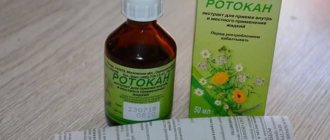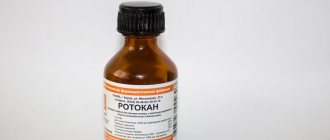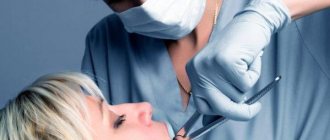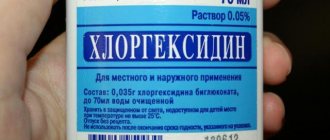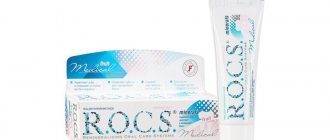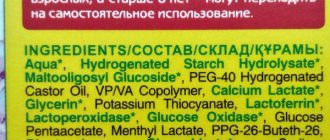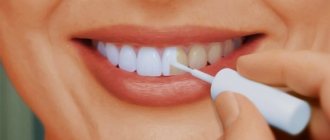Description of the drug Rotokan
Rotocan is produced in brown glass bottles and is a liquid with a specific smell of medicinal herbs. Sometimes you can find sediment at the bottom of the bottle.
The solution contains:
- calendula;
- chamomile;
- yarrow.
Calendula disinfects and relieves inflammation. The flowers of the plant contain flavonoids and carotenoids. Chamomile has a calming effect on inflamed mucous membranes and has antiseptic properties. The flowers of the plant contain coumarins, phytosterol, flavonoids and choline.
Yarrow herb contains tannins that destroy pathogenic microorganisms. Alkaloids have a hemostatic effect, while resinous substances promote the restoration of damaged tissues and rapid healing.
The basic basis of the medicine is ethyl alcohol diluted with purified water. Like all preparations based on herbal raw materials, Rotokan for teeth does not produce side effects if a person is not allergic to the herbal raw materials included in its composition. You can buy Rotokan at the pharmacy without a prescription.
Medicinal properties of the drug:
- antiseptic;
- anti-inflammatory;
- anesthetic.
The action of the active substances of the drug is aimed at destroying pathogenic bacteria.
Medicinal properties
The pharmaceutical product Rotokan has a complex effect. The combined effect of the drug components ensures a positive treatment result in dental and otolaryngological practice.
The presence of chamomile provides the following effects:
- anesthetic
- antispasmodic
- anti-inflammatory
The bacteriostatic and anti-allergenic effect is ensured by the azulenes contained in the raw material.
Medicinal calendula enhances antimicrobial and some other effects.
Organic acids contained in plants have a detrimental effect on pathogenic organisms.
The antioxidant effect of the drug is ensured due to the presence of carotenoids and lycopenes.
The external hemostatic and healing effect is manifested thanks to the substances that make up the yarrow plant:
- terpenoids
- flavonoids
- complex chemical substances belonging to the aromatic series
Rotokana contains medicinal components that speed up the stop of bleeding in the mouth. The mechanism of action of the drug is based on:
- increased blood clotting
- reducing blood flow to the damaged area
Indications and contraindications
Rotokan is prescribed for:
- pustular formations;
- stomatitis and ulcers;
- periodontal disease and gingivitis.
Rotokan for rinsing gums is also used to prevent infection from entering the mucosal cells during wound mechanical damage - bites, tooth root removal and other dental procedures. The remedy is also prescribed after cleaning the crown from tartar.
Contraindications
- with alcohol addiction;
- pregnancy/lactation;
- allergy to plant materials;
- brain injuries;
- minor children.
Rotokan during pregnancy: rinse the gums with extreme caution so as not to harm the fetus.
Indications for use
For inflammation of various etiologies, dentists and ENT doctors often prescribe Rotokan to patients. Germs and damage, burns can cause bleeding, pain and swelling.
For stomatitis, the medicine is very effective at the first stage of the pathology. It affects bacterial and fungal infections and quickly destroys them.
Indications for treatment with Rotokan for dental pathologies:
- periodontal disease
- tooth socket disease
- periodontitis
- gingivitis
- various stomatitis
- necrotizing gingivostomatitis
For pathologies of the pharynx and tongue, the drug is used for rinsing.
Treatment with Rotokan helps reduce inflammation with tonsillitis, pharyngitis, and glossitis.
Pathologies of the digestive system when the drug is prescribed orally:
- gastroduodenitis
- enterocolitis
- gastritis with low acidity of gastric contents
- chronic enteritis, inflammation
- functional dyspepsia
How to use
Rotokan instructions for rinsing teeth:
- shake the bottle several times;
- open the lid;
- Dissolve a teaspoon of the product in a cup of warm water;
- can now be used for its intended purpose.
Is it possible to increase the dosage of Rotokan solution for gums? If there is no discomfort after rinsing, it is permissible to increase the dosage three times (dissolve three spoons in a cup of water).
How long to keep Rotokan in your mouth for stomatitis? You can rinse for a minute, then spit out the solution. The medicine should not be swallowed. If you do not use the entire cup of solution in one go, discard the rest.
What happens if the solution accidentally gets inside while rinsing? There is nothing dangerous. But it is better to carefully rinse your mouth and spit, so as not to swallow pus or mucus from the oral cavity with the solution.
Additional instructions
- rinse daily for 5 days in a row - several times a day;
- make gauze applications to the affected areas, if possible - apply for 15-16 minutes several times a day;
- To treat periodontitis, a cotton wool tourniquet soaked in the product is placed in the gum pocket for 20 minutes - healing occurs on the third day.
When treating periodontitis, additional rinsing with a solution dissolved in water is used 2 or 3 times a day. Flagella (turundas) soaked in Rotokan are placed once a day. If healing does not occur, it is not recommended to use turundas more than six times.
Alcohol tincture from herbs cannot be used in its pure form, so as not to burn the mucous membrane.
Removal of a tooth
Is it necessary to use Rotokan after tooth extraction, and what are the dangers of root removal? There is no consensus regarding rinsing the mouth after dental surgery. Some doctors believe that rinsing with solutions removes a naturally formed blood clot, which acts as a barrier against the penetration of dirt and infection into the wound.
The ban on rinsing after surgery to remove a root/tooth is based on the assertion of possible suppuration of the wound and the spread of infection on the surface of the gum tissue. However, a number of doctors consider rinsing necessary. Why? Their arguments are based on the following arguments:
- rinsing helps remove food particles after eating;
- eliminates the accumulation of microorganisms in the wound;
- creates the prerequisites for rapid tissue healing.
If there are carious, untreated teeth around the wound surface after root removal, the risk of infection is very high. Bacteria can also move into the wound from poorly cleaned teeth and plaque.
This condition of the oral cavity can lead to the development of alveolitis and foci of inflammation in the wounded gum. Timely sanitation reduces the aggressiveness of microorganisms and eliminates their impact on the wounded mucosa.
For sanitization, you can use medical products, soda/salt solutions and infusions of medicinal herbs.
How to rinse your mouth correctly? You should keep the medicinal solution in your mouth without active action of the facial muscles: do not rinse, but arrange a medicinal bath inside the oral cavity. After holding the solution, you should simply spit the liquid out of your mouth. Baths should be done every 15-16 minutes until the mucous membrane heals. In this case, the blood clot will not be washed out of the wound and will continue its protective effect.
Adviсe:
- stop eating/drinking immediately after surgery;
- do not use tobacco and alcoholic beverages for a while;
- do not go to the steam room or take a hot bath/shower on the day of surgery;
- exclude heavy physical activity and psychological stress.
Compliance with the recommendations listed will facilitate the healing of the wound surface.
Flux treatment
Sometimes gum inflammation can take you by surprise on weekends/holidays. What to do if your cheek is swollen from gumboil, and Rotokan is not in the first aid kit? The drug can be replaced by:
- Malavit;
- Furacilin;
- Chlorhexidine;
- Betadine.
If the listed drugs are not available, a soda-salt solution (a teaspoon of each component in a cup of warm water) or medicinal herbs, for example, oak bark, will help. Thanks to tannins, the product destroys pathogenic flora and cleanses the mucous membrane.
How to use Rotokan for flux? You should prepare a solution of the drug and moisten a gauze or cotton pad, then apply the material between the gum and cheek for 20 minutes. There is no need to rinse your teeth after application; refrain from drinking/eating for a while to consolidate the healing effect.
Treatment methods in gynecology
Rotocan in gynecology, douching, is the topic of our article today. As everyone knows, gynecology is the field of medicine that deals with the study of various female diseases.
What is douching in gynecology? This is a method of washing the vagina using various medicines or herbs. This procedure cannot be carried out without consulting a doctor, since unknowingly you can disrupt the delicate microflora of the vagina and cause undesirable consequences instead of the desired result. If you do the procedure thoughtlessly, it can cause disturbances in the vaginal environment and such an unpleasant disease as vaginosis.
Also, frequent use of this procedure can cause the development of thrush. This is far from a typical procedure for medical practice, and it has its pros and cons. Since it washes out the necessary bacteria and disrupts the microflora, not many specialists are ready to prescribe it. If your gynecologist prescribed this procedure for you, then you should strictly adhere to his recommendations, this is in order to preserve your health. Nowadays, this procedure is increasingly receding into the background, and gynecologists are trying to replace it with methods that are more gentle on the body.
Some doctors are inclined to believe that douching during erosion can damage the epithelium of the cervix, and therefore do not use it.
Reviews about the product
Svetlana, 27 years old:
I often use Rotokan for toothache and gum swelling. The wisdom tooth does not erupt in any way and periodically gives a signal of itself with unpleasant painful sensations. Rotokan fixes the problem very quickly.
Galina, 46 years old:
After removing wisdom teeth or damaged carious stumps, you should not rinse with hot soda or saline solutions. A friend of mine did this and ended up bleeding from her gums. The doctors barely stopped him. I take baths from Rotokan/Romazulan for a few seconds, but often. You can’t gurgle in your mouth, you just need to take some liquid and hold it.
Marina, 29 years old:
They removed my tooth, and in the evening I decided to treat the wound with traditional decoctions (sage and chamomile). And that’s what happened - particles of grass got into the wound. I filtered the broth, but the wound was still clogged. Then I learned that you can’t actively gurgle in your mouth, and it’s better to use Rotokan solution instead of traditional herbs. I'll keep this in mind for the future.
Tamara, 37 years old:
My husband got a flu infection on Saturday. A neighbor advised me to make lotions from Rotokan - soak gauze and apply it. Thank you very much for the advice: at first the flux stopped hurting, then it began to decrease. Along with the lotions, my husband also rinsed his gums slowly - he held the liquid in his mouth and spat.
Bottom line
If you follow the instructions correctly, Rotokan will relieve swollen gums, remove ulcerative formations on the mucous membrane and neutralize the oral cavity from pathogenic agents - microbes.
When using Rotocan, after removing a tooth root, you should first rinse your mouth with boiled water, and only then take a medicinal bath with the drug. Active movements of the facial muscles should not be allowed.
In the presence of serious systemic disorders of the body (renal failure, etc.), the drug is not recommended. The use of the product by children is prohibited as it contains alcohol.
Sources used:
- Preventive dentistry / I.K. Lutskaya. - Moscow
- Diagnosis, treatment and prevention of periodontal diseases / A.I. Nikolaev. - M.: MEDpress-inform, 2008.
- Apteka.ru
Choosing a gum rinse
Mouthwashes can be therapeutic, that is, intended for the treatment of specific diseases, and prophylactic, which are recommended by dentists as an additional means of caring for the oral cavity. It is better to select the first ones under the supervision of a doctor, taking into account the individual characteristics of the course of the disease. The latter can be divided into 4 types:
- for the prevention of caries;
- for teeth whitening;
- for gum treatment;
- for comprehensive protection of gums and teeth.
When choosing a mouthwash for each specific purpose, give preference to well-known manufacturers and carefully read the instructions for use. Startsmile recommends.
- CURASEPT ADS 205. Gum rinse contains fluorides and vitamin C. Protects against caries and is not addictive. Recommended for comprehensive care of braces and dentures.
- 4-action Mouthwash. Biorepair offers the ideal rinse option for teeth and gums that are hypersensitive. The rinse restores enamel and prevents caries.
- Paroguard CHX Miradent. Has a pronounced anti-inflammatory effect. Contains chamomile extract. Does not require dilution with water, which makes it convenient for travel or business trips.
- PresiDENT Profi. Therapeutic solution for rinsing gums based on Chlorhexidine. Does not contain ethanol. Suitable for irrigator. Recommended as a rinse for gum periodontal disease.
- "Prevention of gum disease" Donfeel. Can be used for daily care. Removes plaque, has a bactericidal effect and promotes mucosal regeneration.
ATTENTION!
Exceeding the concentration of ethanol in the mouthwash provokes dryness of the oral mucosa!
